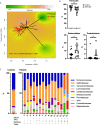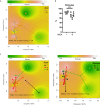Fecal Bacteria Implicated in Biofilm Production Are Enriched and Associate to Gastrointestinal Symptoms in Patients With APECED - A Pilot Study
- PMID: 34367134
- PMCID: PMC8339580
- DOI: 10.3389/fimmu.2021.668219
Fecal Bacteria Implicated in Biofilm Production Are Enriched and Associate to Gastrointestinal Symptoms in Patients With APECED - A Pilot Study
Abstract
Backgrounds and aims: APECED is a rare autoimmune disease caused by mutations in the Autoimmune Regulator gene. A significant proportion of patients also have gastrointestinal symptoms, including malabsorption, chronic diarrhea, and obstipation. The pathological background of the gastrointestinal symptoms remains incompletely understood and involves multiple factors, with autoimmunity being the most common underlying cause. Patients with APECED have increased immune responses against gut commensals. Our objective was to evaluate whether the intestinal microbiota composition, predicted functions or fungal abundance differ between Finnish patients with APECED and healthy controls, and whether these associate to the patients' clinical phenotype and gastrointestinal symptoms.
Methods: DNA was isolated from fecal samples from 15 patients with APECED (median age 46.4 years) together with 15 samples from body mass index matched healthy controls. DNA samples were subjected to analysis of the gut microbiota using 16S rRNA gene amplicon sequencing, imputed metagenomics using the PICRUSt2 algorithm, and quantitative PCR for fungi. Extensive correlations of the microbiota with patient characteristics were determined.
Results: Analysis of gut microbiota indicated that both alpha- and beta-diversity were altered in patients with APECED compared to healthy controls. The fraction of Faecalibacterium was reduced in patients with APECED while that of Atopobium spp. and several gram-negative genera previously implicated in biofilm formation, e.g. Veillonella, Prevotella, Megasphaera and Heamophilus, were increased in parallel to lipopolysaccharide (LPS) synthesis in imputed metagenomics. The differences in gut microbiota were linked to patient characteristics, especially the presence of anti-Saccharomyces cerevisiae antibodies (ASCA) and severity of gastrointestinal symptoms.
Conclusions: Gut microbiota of patients with APECED is altered and enriched with predominantly gram-negative bacterial taxa that may promote biofilm formation and lead to increased exposure to LPS in the patients. The most pronounced alterations in the microbiota were associated with more severe gastrointestinal symptoms.
Keywords: atopobium; autoantibodies; autoimmunity; dysbiosis; faecalibacterium; gut microbiota; immune dysregulation; lps.
Copyright © 2021 Hetemäki, Jian, Laakso, Mäkitie, Pajari, de Vos, Arstila and Salonen.
Conflict of interest statement
The authors declare that the research was conducted in the absence of any commercial or financial relationships that could be construed as a potential conflict of interest.
Figures




Similar articles
-
Gastrointestinal Autoimmunity Associated With Loss of Central Tolerance to Enteric α-Defensins.Gastroenterology. 2015 Jul;149(1):139-50. doi: 10.1053/j.gastro.2015.05.009. Epub 2015 May 15. Gastroenterology. 2015. PMID: 25982289
-
Anticommensal Responses Are Associated with Regulatory T Cell Defect in Autoimmune Polyendocrinopathy-Candidiasis-Ectodermal Dystrophy Patients.J Immunol. 2016 Apr 1;196(7):2955-64. doi: 10.4049/jimmunol.1500301. Epub 2016 Feb 22. J Immunol. 2016. PMID: 26903483
-
Gastrointestinal manifestations in APECED syndrome.J Clin Gastroenterol. 2013 Feb;47(2):112-20. doi: 10.1097/MCG.0b013e31827356e1. J Clin Gastroenterol. 2013. PMID: 23314667 Review.
-
The Roles of Inflammation, Nutrient Availability and the Commensal Microbiota in Enteric Pathogen Infection.Microbiol Spectr. 2015 Jun;3(3). doi: 10.1128/microbiolspec.MBP-0008-2014. Microbiol Spectr. 2015. PMID: 26185088
-
Microbiome Regulation of Autoimmune, Gut and Liver Associated Diseases.Inflamm Allergy Drug Targets. 2015;14(2):84-93. doi: 10.2174/1871528114666160128150747. Inflamm Allergy Drug Targets. 2015. PMID: 26817477 Review.
Cited by
-
Lessons From Prospective Longitudinal Follow-up of a French APECED Cohort.J Clin Endocrinol Metab. 2025 Feb 18;110(3):e757-e773. doi: 10.1210/clinem/dgae211. J Clin Endocrinol Metab. 2025. PMID: 38605470 Free PMC article.
-
Zuogui Jiangtang Jieyu prescription improves diabetes-related depression by modulation of gut microbiota and neuroinflammation in hippocampus.Heliyon. 2024 Oct 15;10(21):e39291. doi: 10.1016/j.heliyon.2024.e39291. eCollection 2024 Nov 15. Heliyon. 2024. PMID: 39524747 Free PMC article.
-
Reduction in mucosal-associated invariant T cells (MAIT) in APECED patients is associated with elevated serum IFN-γ concentration.Eur J Immunol. 2024 Dec;54(12):e2451189. doi: 10.1002/eji.202451189. Epub 2024 Sep 18. Eur J Immunol. 2024. PMID: 39292205 Free PMC article.
-
Inborn errors of immunity and related microbiome.Front Immunol. 2022 Sep 13;13:982772. doi: 10.3389/fimmu.2022.982772. eCollection 2022. Front Immunol. 2022. PMID: 36177048 Free PMC article. Review.
-
Gastrointestinal manifestations in autoimmune polyendocrinopathy-candidiasis-ectodermal dystrophy (APECED) patient: major effect on treatment and prognosis.Endocrinol Diabetes Metab Case Rep. 2023 Apr 17;2023(2):22-0352. doi: 10.1530/EDM-22-0352. Print 2023 Apr 1. Endocrinol Diabetes Metab Case Rep. 2023. PMID: 37067225 Free PMC article.
References
Publication types
MeSH terms
Substances
LinkOut - more resources
Full Text Sources
Medical
Miscellaneous

